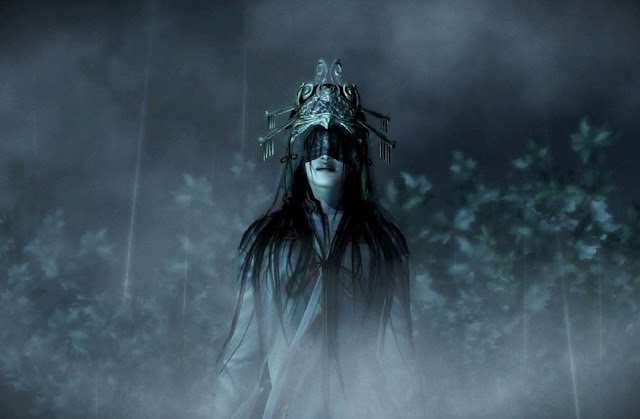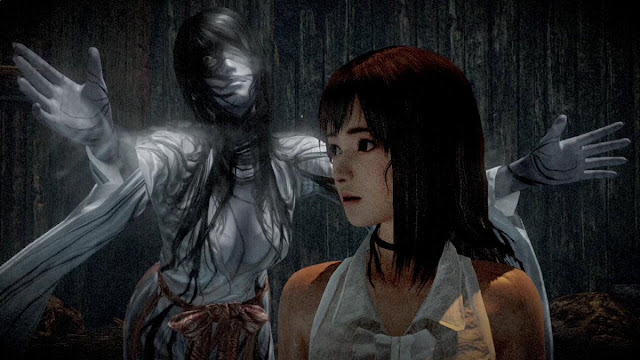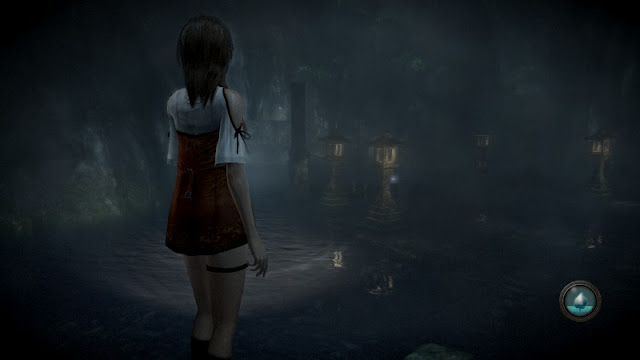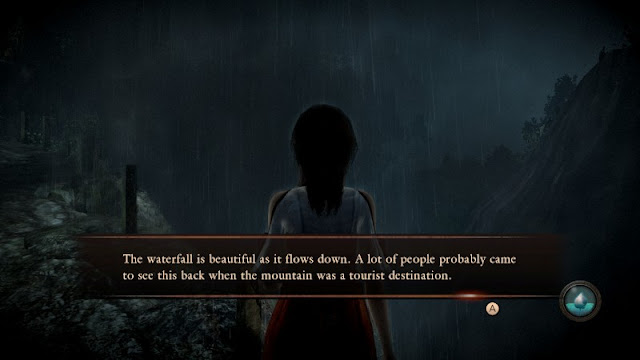I have an fascination with water. Give me a camera and I can spend a whole day photographing the ocean, a river or a waterfall, for example. It’s not just that water is so essential to life that it appeals to me; it’s the aesthetics of water that I find so compelling. The motion of it, the elegance, the power of it. And the way it interacts with people is just as interesting; as a requirement to life, as a mirror. As something that can relax and revitalise us. Water is truly a fascinating source of inspiration for an artist to work with.
Related reading: Project Zero is exclusive to the Nintendo Wii U, but if you’re looking for a narrative horror game on another platform we recommend Until Dawn on the PlayStation 4.
So when a game takes the motif of water and then makes it central to the entire narrative drive of the experience, it has a powerful emotional effect on me, by connecting it to something I do find so intensely beautiful. Project Zero: Maiden of Black Water is one such game. It takes the natural beauty and tranquility of water, and sets it against the unnatural horror of ghosts and spirits. The water of this game is deeply corrupted and sinister, which made me incredibly uncomfortable, and dreading what I knew was coming up each and every time I came across a pool of water or a waterfall through the adventure. This may well be the first game where I found my character standing at the edge of a body of water and I was dreading pushing on.
The Project Zero, or Fatal Frame (as it is known in America), series, has always been a deeply frightening horror series, but it has always been less a horror of physical threat, and more a case of a slow, methodical, intellectual and psychological fear. As I mentioned in my recent review of Corpse Party, Japanese horror, when it is at its best, is not about monsters or other ugly things in the dark. They might be there within the narrative, but when it’s at its best, Japanese horror is instead focused on telling sad stories of tragedy. Few game franchises have been a better case-in-point of that than the Project Zero series, and this latest iteration is no different in that regard.
Set in a (fictional) rural corner of Japan, Project Zero: Maiden of Black Water comes from the urban myths that have been associated with the (real) Aokigahara that sits at the base of Mt. Fuji; a forest that has developed a reputation for being a place where people go to commit suicide, and has had urban myths and supernatural mysteries created around that reputation. The game follows the story of three key protagonists as they work to uncover and understand a mysterious tragedy that has claimed the lives of an awful lot of people, as well as the malevolent spirits that continue to pose a threat to visitors to this day. It’s heavy-handed, but quite an effective way to set up an emotional context for the narrative when, in the first real chapter of the narrative, you’re chasing a girl who may have gone up the mountain to commit suicide, and witness apparitions leaping off cliffs. Immediately you know that this is a story that’s going to tell some pretty heart-wrenching tales of sadness and woe, even as it leaves behind monsters that want your protagonist dead.
Then it starts delving into themes around sacrifice and ritual, spirituality and morality, and the narrative stakes only intensify. But for all that, the game’s strongest narrative is told through its atmosphere, and that water motif. As your protagonist gets wet (wandering through a waterfall, wading through a pool of water), they become an easier target for the angry spirits, who generally had an affiliation with the damp, dripping environment. On the up side this generally means that once you’re on dry land you’ll get to enjoy a breather (though at times that is a false sense of security), but on the other, it means that every time you come up to a pool of water, you know you’re in for a bad time ahead.
It’s a pretty intense theme, when you think about it. Water is core to life, so to be encouraged to actively avoid touching it taps right into one of the horror genre’s most effective tricks; to make the natural and mundane represent something dangerous, and to make something we take for granted something we can no longer trust. As the protagonist gets wet, their clothes cling to their bodies, and water streaks across their skin. It’s like a corruption infesting their very being; one that can’t really be escaped from, and one that can’t be resisted. You can’t jump into a pool of water and not get wet, after all.
Having now played the game through in full, I’ve got to say that I’m very disappointed in Nintendo’s decision to censor the swimwear costume from the game. I feel that the state of nearly nakedness actually would have had contextual value to the narrative, emphasising the impact of the wetness, and the vulnerable state that it leaves the character in. If anything, I think a costume such as the one that was censored should have been the default. I don’t know how the script could have justified it, but thematically that costume would have been perfect for highlighting the interaction between water and body that is so core to Project Zero: Maiden of Black Water. Actual nakedness might have been even more effective, though we’re a very long way away from games having that kind of respect as artistic projects that nudity would be allowed to be used for thematic purposes.
Anyhow. I digress. In Project Zero, it’s not just the water that the protagonists struggle to fight back against. As with other titles in the series, their ability to fight back against the malevolent spirits is also very limited. All they’ve got is a decrepit old camera, which has the ability to “hurt” ghosts by taking photos of them (a clever play on the large number of real-world cultures that believe to take a photo of someone is to take their spirit from them), but it’s hardly the kind of security blanket that other “horror” games such as Resident Evil provide the player when they give them machine guns and explosives to play with.
Even as the sole weapon, this Camera Obscura’s ability to fight the ghosts is limited; they need to be very close to the person taking the photo in order to take much damage from the shot, so one of the most interesting quirks about Project Zero is that in order to defeat the ghosts, you’ll often find yourself actually trying to close the gap to get closer to them. This is a remarkably effective way in generating tension, by forcing players to actively resist, and even veto, the ‘flight’ response mechanism that you’re meant to revert to when experiencing something terrifying. Unfortunately on a technical level this system doesn’t work as well as it should, as it requires you to manoeuvre the gamepad around like it was a camera, which I found difficult to come to terms with in the heat of the moment, but part of that is user error on my part, and I think other people will fare far better with this control structure than I did. Either way, thematically, I loved it.
Project Zero games are also well known for being textbook cases of aesthetics being more important than technical expertise. Project Zero 2 on the PlayStation 2 and Nintendo Wii remains one of the most gorgeous horror games ever produced because it showed such an eye for detail in the Japanese architecture of its setting. This new game is, in simple terms, a HD take on that, and proof that the Nintendo Wii U, in the hands of the right development team, is able to craftily carve out art direction as impressive as anything you’ll see on the other two consoles. The recurring water motif is emphasised beautifully from the slick water effects, and combines beautifully with the vision of rotting timbers and absolute nature of the dark corners within the buildings. That combination gives the environment a mouldering, chilly atmosphere that subtly reinforces the real dangers that the characters face. In the real world we know the risks of wet, old wood. In the back of our minds, that inherent unsafeness of the environment adds another layer to the more immediate dangers that the ghosts represent.
The adventure also ventures outside at times, and this is where I think Project Zero: Maiden of Black Water has its greatest impact. If you’ve ever sat by yourself in a pool of water on a hot summer’s night, or gone for a late night soak under a waterfall, then you’ll know that there is perhaps no more true sense of the word “tranquility” than the mix of water, isolation, and darkness. That Project Zero would turn that into something dangerous is in many ways the epitome of its aesthetics and themes.
Fatal Frame’s environments also make good use of tight corridors and sharp angles to generate a sense of claustrophobia and isolation. It also does a good job of hiding the Wii U’s performance weaknesses and limiting the space around a character to explore. It’s a little too linear at times (or, more accurately, most of the time), and the artificiality of it really hampers the suspension of disbelief in the outdoor areas (“I can’t make a shortcut through that bunch of trees why?”), but as a consequence of having the most detailed character models and environments that we’ve ever seen on the Wii U, it’s not such a bad trade-off, and, as I noted, often helps, rather than hinders, the atmosphere.
Project Zero: Maiden of Black Water is, generally speaking, the most straightforward and least challenging of the games in the series. Previous titles had far more complex puzzles and boss battles, but I felt that this game was much more interested in driving players towards its conclusions. On a personal level this doesn’t concern me, as I’m in horror games for the narrative, not the “gameplay,” but it might disappoint purists looking for a greater level of challenge. The game is organised into chapters, with your performance in each being rated at the end, so getting a top rating in each chapter provides some moderate replay value.
But really, Project Zero games have always been exercises in atmosphere, tension, and storytelling, and Maiden of Black Water is right up there with the best of them. The censorship genuinely hurts something core to the theme of the game, but otherwise I can’t recommend this game highly enough. With Resident Evil now more action than horror, and Silent Hill on life support, it’s good to see one classic Japanese horror franchise sticking to its traditions.
– Matt S.
Editor-in-Chief
Do you enjoy horror games?
— Digitally Downloaded (@DigitallyDownld) November 9, 2015











